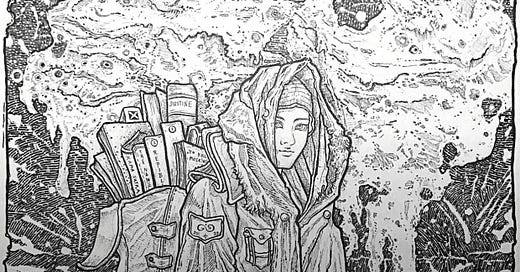"The Library of Forgotten Future," Semper's latest solo exhibition, brings together epic drawings on canvas and paper, book sculptures, and collaborative new media works, imagining stories of people in a post-apocalyptic world where society and nations have deemed books obsolete, unimportant, or purposeless. These heroes are book lovers – "collectors" in the sense that their life mission is to salvage old yet valuable records of humanity, thereby rescuing and preserving our heritage.
Semper's creative process reflects his expansive exploration. The artist's drawings are executed in the style of old master prints such as those of German Renaissance artist Albrecht Dürer, or the symbolic and tropological works of William Blake, the surrealists, and symbolists. His grayscale drawings have some affinities with Gustave Doré, but with a personal mythological ambit, drawing on local historical or fictional narratives, and supernatural folk traditions of the Philippines, all the while referencing conceptual inspirations from metaphysics, alchemy, world mythology, classical arts, esoteric arts, among others – a synthesis of various archetypes invoked from both ancient civilizations to contemporary pop culture.
Images generated by AI (Artificial Intelligence) further inspire Semper's collage of ideas, images, and symbols. Texts are fed into AI Generators, which re-imagine a slew of chimeric images based on available data from humanity's collective digital footprint. The artist then arranges and re-arranges these co-authored imaginings, drawing them seamlessly on a page to represent an
instance in time where dimensions collide. While it may appear that these are artificial creations with no human touch, Semper acknowledges the intelligence in these generators: they carry human information in systemic form, a collection of all our images fed into a machine which forms and reforms humanity’s world of words.
In Graveyard of Books (2022), Semper depicts a post-apocalyptic cyberpunk figure carrying a backpack full of books. This literary selection includes titles that influenced previous generations from which the figure may have descended. He is captured among a ruin of scattered volumes from a lost civilization. "A terrifying prophetic depiction that will become a reality no sooner if we lose interest in books today," Semper writes. In The Librarian (2022), an elderly woman is shown propped up on a ladder, reading a journal from her collection. A mental image of a cosmic library appears in her mind's eye – a fantasy of an infinite collection of information that she might share with a world where reading is, per Semper, “as rare as finding diamonds in the wild.”
However, this affinity for published compendiums also raises questions about their ideologies. Semper casts his own autonomy on actual book pieces by several artists and writers from the Western art historical and literary canons in a series of defacements. In Psalm of Shadows (2022), the artist alters an Andy Warhol work by casting shadows on its surface, thereby projecting Semper’s own unconscious force into Warhol's. The artist also alters the structures of some reminiscent of Anselm Kiefer, providing a commentary on their social legacy, but more importantly a reflection on their emancipatory potential, in a set of four book sculptures titled after the alchemical transformation stages of matter as earth, water, air, and fire: Nigredo, Citrinitas, Albedo, and Rubedo (all 2022). In Ayn Rand Shrugged (2022), Semper vandalizes Rand’s Atlas, a seminal manual on objectivism. Recalling the Greek mythological figure who carried the celestial globe as punishment for waging war against Zeus, the artist’s alterations call attention to his denouncement of a world of self-interest where altruism is deemed destructive. In his own words, “It’s now time to create and recreate, a time to re-enchant.”
And so, the call to create, recreate, and re-enchant becomes a collective summon. In the religion of theosophy and the philosophical school of anthroposophy, there is a metaphysical library called the Akashic Records, a stupendous compendium of all universal events, thoughts, words, emotions, and intent that have ever happened in the past, present, or future in terms of all entities and life forms, not just humans. As we keep the legacy of books, we carry their creators' intentions with ours throughout time: their call for freedom, or some universal principle becomes ours. Indeed, when we invoke enchantment in the realms of literature or art, we might discover its limitless potentials. Magic, in all of its ruminations, alterations, and contemporary interpretations, remains an important counter-cultural force and liberative strategy: enchantment becomes a weapon against self-interest or a systemic, conditioned forgetting. Looking forward to the future, if you want to read a book that hasn't yet been written, you must be the one to write it.
John Alexis Balaguer
in case you missed…




